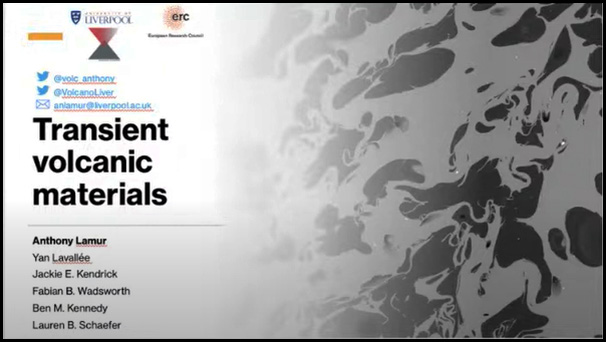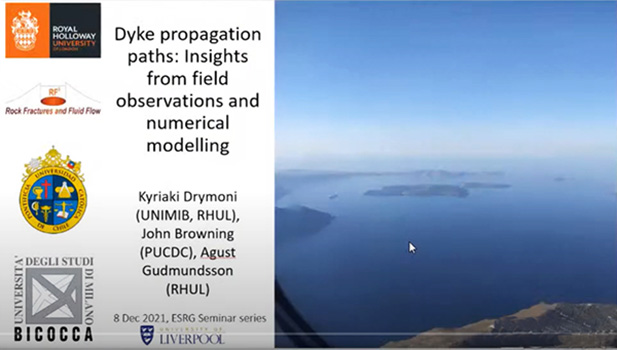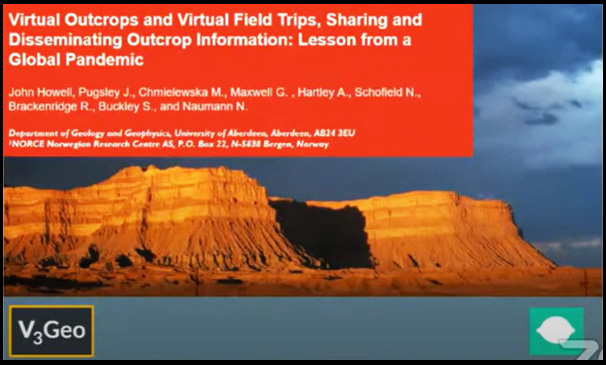The Earth Science Research Group (ESRG) at the University of runs a weekly online seminar series, dedicated to showcasing a variety of exciting and important work that’s going on in the field. During 2021 the ESRG seminar series started to be held virtually for the first time. One of the best things about having a virtual seminar series was that it has facilitated national and international speakers sharing their research from their own home or office. The recordings provide an important resource for the Earth Science community and for teachers of Earth Science, allowing them to expose their students to scientific seminars and research.
Anthony Lamur

Volcanoes are inherently heterogeneous, from the haphazard construction of their edifice to the evolution of shallow magma and associated eruptive activity. They also experience widely ranging internal stresses, influenced by magma and gas, and external stresses including changes in overburden and disturbances from regional earthquakes, all of which may impact the properties of volcanic materials. In this talk, Anthony discusses the development of damage, both accumulation and loss, in magma and volcanic rocks, which impacts their strength, coherence and fluid circulation, all of which can tip volcanic systems over certain thresholds to potentially increase volcanic hazards.
Kyriaki (Sandy) Drymoni

Dyking is the most common process of magma ascent in the shallow crust. Dykes and inclined sheets are known occasionally to exploit faults as parts of their paths, but the conditions that allow this to happen are still not fully understood. In this talk I will report field observations from a swarm composed of 91 segments of dykes and inclined sheets, the swarm being particularly well-exposed in the mechanically layered caldera walls of the Santorini volcano, Greece. Here I combine the field data with numerical models to explore dyke paths resulting in (1) arrest and (2) eruption as well as new analytical and numerical models to explain the mechanical principles of dyke/sheet deflections into faults. Finally, I investigate the effect of different host-rock mechanical properties, magmatic overpressures, and tectonic loading on dyke paths.
John Howell

Over the past 20 years, virtual outcrops have transitioned from a niche research area into a mainstream tool in the geoscientist’s arsenal. The advent of inexpensive consumer UAVs (drones), easy to use processing software and dedicated interpretation software have resulted in an explosion in their uptake which was accelerated by the COVID pandemic. This increase in uptake has facilitated to issues, firstly how to share models within the community and secondly how to optimize their use in Virtual Fieldtrips. There have been several initiatives to facilitate the public sharing of virtual outcrop data via website and online databases. V3Geo.com was launched in April 2020 to provide virtual outcrop data to groups and institutions who were unable to visit the field due to the global lockdown. The site allows search and navigate around virtual outcrops from over 250 key geological sites. The most recent release allows anyone to up-load and publish their own models directly. There is a long-term goal of providing a public resource that captures all the key outcrops in the World and beyond.
Rob Duller

Sediment flux holds key information about past climate and rates of tectonic uplift (i.e. environmental or allogenic forcing). Changes in sediment flux can affect Earth surface processes, which in turn can be archived in the strata providing sufficient subsidence has taken place. Usually any changes in the characteristics of the strata are interpreted solely in terms of allogenic forcing. However, we know that processes internal to the transport system (i.e. autogenic processes) are also in operation and can leave a signature in strata, potentially overprinting allogenic signals. How can we tease allogenic signatures out from autogenic signatures in strata? To answer this we present a theoretical framework for channelized clastic systems that sets limits on sediment flux signal storage in strata. We test this framework using a suite of laboratory experiments. Come to the talk to see if it all worked out. The approach outlined here offers a much-needed null hypothesis to field scientists wishing to explore strata for signatures of Earth’s past response to environmental forcing.

